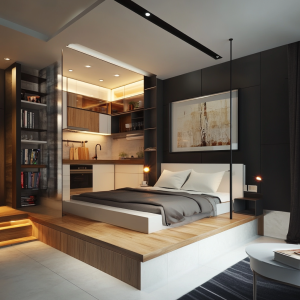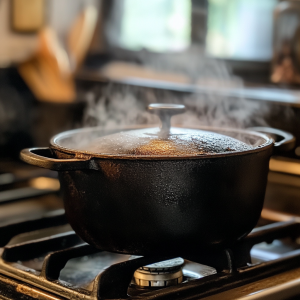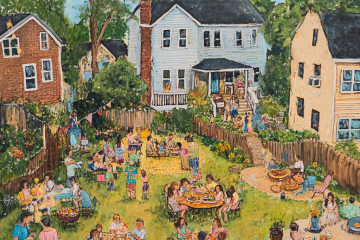
Studio apartment living and preparedness
In today’s urban landscape, many of us find ourselves living in apartments or studio dwellings where space is at a premium. However, limited square footage doesn’t mean you have to compromise on your preparedness goals. With some creativity and smart planning, you can build a robust preparedness strategy even in the coziest of spaces.
The Foundation: First Four Principles of Preparedness
Before diving into the practical aspects of small-space prepping, it’s crucial to understand that true preparedness begins from within. Focus on these first four fundamental principles, in order of prioritization, which require little space and money but yield significant benefits:
- Spiritual Preparedness: Cultivate inner strength through meditation, prayer, or mindfulness practices. These can be done in any corner of your home and will help you maintain calm and clarity during challenging times. You’ve got to have your core value system in place or nothing else will matter.
- Mental Preparedness: Keep your mind sharp by reading, solving puzzles, or learning new skills. Consider taking online courses in survival techniques or emergency management. Be sure to practice situational awareness.
- Physical Preparedness: Stay fit with bodyweight exercises that can be done in small spaces. Yoga, push-ups, and squats are excellent options that require no equipment.
- Medical Preparedness: Learn basic first aid and CPR. Keep a compact but comprehensive first aid kit on hand, and consider taking online courses to expand your medical knowledge.
By strengthening these areas, you’ll be better equipped to handle emergencies, regardless of your living situation.
Maximizing Space: Creative Storage Solutions
When it comes to physical preparations in small spaces, creativity is key. Here are some ingenious ways to maximize your storage:
- Utilize Vertical Space: Install tall shelving units and use over-the-door organizers to make the most of your walls and doors.
- Hidden Spaces: Don’t overlook the space behind books on bookshelves or the area close to the floor behind sofas and ottomans. These can be perfect for storing emergency supplies.
- Multi-purpose Furniture: Invest in beds with built-in storage, ottomans with hidden compartments, and fold-down tables and desks.
- Closet Optimization: Use space-saving hangers and store supplies in shoe organizers to make the most of your closet space.
- Vacuum Sealing: Use vacuum-sealed bags for clothing, bedding, and even some food items to significantly reduce their storage footprint.

Make use of every inch
It may be interesting to note that an entire year’s supply of food can fit in the foot print of a twin sized bed, under the bed more specifically. So it doesn’t have to take up as much space as you might imagine.
Nutrition and Food Storage
In small spaces, focus on compact, calorie-dense foods that offer good nutritional value:
- Dried goods: Beans, rice, and pasta are excellent staples that store well in small spaces, though you’ll need quite a bit of water to cook those beans so you may want to stock up on canned beans.
- Protein sources: Peanut butter, nuts, and canned meats and fish provide essential proteins in a compact form.
- Sprouting: This is an excellent way to ensure fresh vegetables and added nutrition without requiring much space. Mason jars or small trays can be used for sprouting various seeds and legumes, providing fresh greens even without a balcony. I suggest that you get one of those modestly priced multi-layer sprouters.
- Vertical Gardening: If you do have a balcony, consider vertical gardening techniques to grow herbs and small vegetables.
Water Storage Solutions
Water is crucial for survival, but storing it can be challenging in small spaces. Consider these options:
- WaterBOB: This bathtub liner can store up to 100 gallons of water in your bathtub during emergencies. As soon as you know one is coming your way such as inclement weather, fill ‘er up!
- Stackable Containers: Look for water containers designed to stack efficiently. Water Bricks fit this need nicely.
- Water Filters: Compact water filter systems like LifeStraw can help you make use of water from various sources in an emergency.
Multi-purpose Equipment
When space is limited, every item should earn its keep. Here are some examples of multi-purpose cooking equipment and tools:
 Cooking Equipment:
Cooking Equipment:
- Dutch Oven: Can be used for baking, boiling, frying, and even as a washing basin.
- Solar Oven: Allows for cooking without electricity and can double as a water purifier. (I recommend the All American Sun Oven)
- Pressure Cooker: Speeds up cooking time, saving fuel, and can be us.
- Cast Iron Skillet: Great for cooking, can be used over any heat source, and adds iron to your diet. Better yet, get a cast iron Dutch oven and you’ve done even better with your money!
Tools:
- Multi-tool: Combines pliers, knife, screwdriver, and more in one compact tool.
- Folding Shovel: Can serve as a shovel, saw, bottle opener, and even a self-defense tool.
- Paracord: Used for cordage, but can also be unraveled for fishing line, sewing thread, or emergency sutures.
- Bandana: Works as a dust mask, water filter, bandage, signal flag, and more. Make it a bright color to have it serve even MORE purposes.
Power and Communication
Even in small spaces, you can prepare for power outages and communication needs:
- Solar Chargers and Power Banks: Compact options for keeping devices charged. (I recommend the Humless Go 300 or 600 at humless.com)
- Hand-crank Radio: Provides information and often includes a phone charger and flashlight.
 : Hands-free lighting that takes up minimal space. Get as many lumens as you can afford. You won’t regret it!
: Hands-free lighting that takes up minimal space. Get as many lumens as you can afford. You won’t regret it!
The “Go Bag”
Finally, prepare a compact “Go Bag” – a backpack with essentials for quick evacuation. Include important documents, cash, a small first-aid kit, some food and water, and a change of clothes.
Remember, preparedness is not about having a vast stockpile of supplies. It’s about being resourceful, knowledgeable, and ready to adapt. By focusing on the four principles of preparedness and creatively using your available space, you can be well-prepared even in the smallest of dwellings. Stay informed, stay prepared, and most importantly, stay safe.


